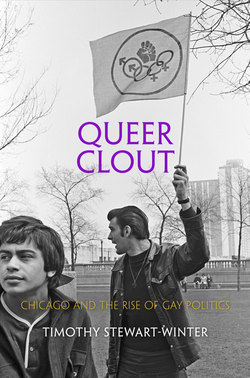Читать книгу Queer Clout - Timothy Stewart-Winter - Страница 12
На сайте Литреса книга снята с продажи.
Оглавление3
_________
Freaking Fag Revolutionaries
BETWEEN 1962 AND 1968, facing increasing police harassment, Chicago’s homophile movement coalesced. Gay Chicagoans created three organizations in the 1960s—a chapter of ONE, a chapter of the Daughters of Bilitis, and Mattachine Midwest—each lasting longer than the three Mattachine chapters founded between 1955 and 1960. Each group held meetings, appointed officers, and sponsored parties. One or two members of the Daughters of Bilitis chapter, and a larger number of Mattachine Midwest participants, also differed from members of the previous groups in their willingness to shed their anonymity and appear in public. Although antiwar and civil liberties activism were important influences on the mobilization of gays, it was the challenge that black Chicagoans were posing to place-based forms of institutional racism that most significantly influenced the trajectory of the local gay movement in this period.
The Northern civil rights movement framed homophile activists’ analysis of the urban political landscape, shaping the movement’s growth and inspiring its greater militancy. Black activists in Chicago, as Mike Royko wrote in 1971, “began by coming downtown with picket signs and demanding better schools.”1 Many of Chicago’s white ethnic voters were drawn to a new politics of law and order, for which their mayor became an emblem. Where breadwinner liberals had called for positive state action to aid orderly households, law-and-order Democrats now called for negative state action to control disorderly individuals. Yet white gay activists instead began to borrow the language of black and New Left challenges to police brutality, using some of the same language and the same tools with which African Americans were challenging the ossified urban machine. Black and gay activists in the late 1960s shared a concern with police behavior because they both encountered aggressive policing in the streets, and their gathering places were disproportionately subjected to police harassment and extortion. Gay leaders staked claims to city streets, parks, offices, and residential buildings; in so doing, they claimed the right to the city. In the spring of 1968, Daley controversially declared, after the uprisings that followed the assassination of Martin Luther King, Jr., that the police should “shoot to kill” arsonists and “shoot to maim” looters. As his party became divided over the war abroad and crime and unrest at home, Daley came to epitomize the defense of “law and order.” A new liberal political faction that supported civil liberties and questioned Daley’s police department began to emerge in Chicago, and gay activists were part of it.
The more involved you were in gay networks—unless you studiously avoided bars and exclusively attended house parties, which were less likely to be raided—the more you worried about the police. Gay activists viewed police with great suspicion; middle-class gays and lesbians simply had more negative experiences with the police than did similarly situated heterosexuals. Cruising on city streets brought gay men into conflict with law enforcement even more frequently than did bar raids. In 1967, gay men in Chicago, nearly all of them white, were asked how often they worried about five possible consequences “when out looking for sex with other men.” The worry that the greatest proportion of respondents said they “often” felt at such moments was “being caught by the police”; 50 percent reported having this worry either “often” or “sometimes.” Of 458 respondents, 115 said they “often” felt this worry, compared to 89 (19 percent) who reported “often” worrying about the second-most common consequence, which was “catching a disease.”2
The makeup of the homophile movement in Chicago in the 1960s does not match the persistent notion that the movement was preoccupied with respectability and elite concerns. Two of Chicago’s new gay organizations were both more diverse in their class makeup and less hostile to the city’s bar-based queer subcultures than one might expect, compared to similar organizations in San Francisco and New York.3 They differed from the chapter of ONE, established in 1965, which shared a name and Los Angeles roots with ONE magazine and was largely a social group for upper-middle-class and professional white men.4 By contrast, the officers of Mattachine Midwest, which was founded in 1965, included left-wing social radicals, a leader of the early 1960s struggle for racial integration in a Chicago suburb, and the manager of a gay bar, as well as some more conservative individuals.5 A prominent Kansas City female impersonator, Skip Arnold, was a featured speaker at one of its early public meetings.6 And the Daughters of Bilitis chapter, founded in 1962 and active through about 1967, was described by the anthropologist Esther Newton as a “group of lower middle-class girls.”7 The editors of the group’s newsletter wrote, “It is true that the women in our organization are mostly non-professionals, but never let it be said that professional people alone make the world go ’round.”8 Although many lesbian activists across the country had begun to leave allmale homophile organizations for the women’s movement, lesbians in Chicago continued to work alongside gay men because the two groups found unity of purpose in opposing police harassment.
